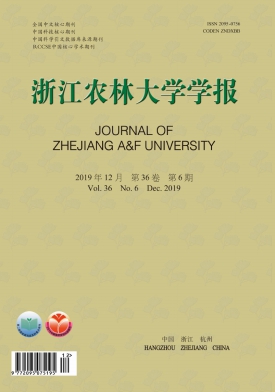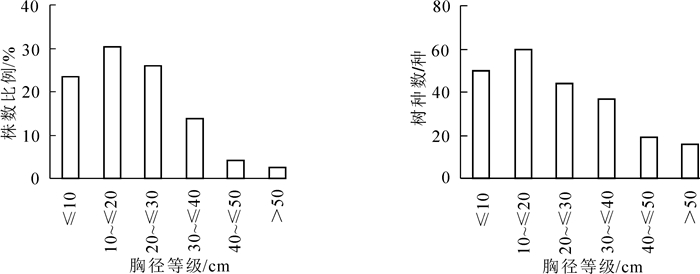-
城市森林是一种与城市发展密切相关的森林类型[1]。城镇化的快速推进加速了植物群落的更新速度,对城市森林提供的生态服务功能提出了更高的要求。由于城市森林直接服务于当地社区和民众,景观美学方面的考量显得尤为重要[2-3],但如果只考虑眼前的景观美学特征,不重视植物群落长期稳定的更替,城市森林将永远无法满足城市可持续发展的需求。植物群落是城市森林生态系统的基础,为人们提供了诸多生态服务功能[2]。每个物种对于构建城市森林植物群落和完善生态系统的功能都至关重要,各个物种在贡献途径和功能性质方面存在差异。在物种多样性指数中,物种在构建植物群落,维持植物生态系统等方面的作用并没有得到完整的呈现。生态系统功能除了与物种的分布格局有关,还与物种具备的功能特征有更为紧密的联系[4]。与物种的多样性相比,植物的功能性状以及系统发育组成等方面的信息对生态功能系统方面出现变化的解释相对更多[5-6]。2个有相同物种多样性的群落,可能会有相似的系统发育信息,但也可能会大不相同[7]。某些群落在一定范围内还会呈现出较低的功能多样性,但是谱系多样性以及物种多样性却会很高[8-9]。为更加全面地认识植物群落的结构变化、演替过程,并预判其未来的变化趋势,需要深入分析多个层面的植物多样性。本研究通过调查海口城市主建成区范围内的植物样方数据集,分析海口城市森林植物群落的结构特征、基调物种等方面的信息,评价城市森林植物群落的整体质量,并探讨植物物种多样性、功能多样性和谱系多样性3个层面多样性指标的相关性。
HTML
-
海口市地处海南岛北部(19°31′~20°04′N,110°07′~110°42′E),总面积3 134.84 km2,其中陆地面积2 304.84 km2。海口市属热带海洋性气候。年日照时间相对较长,年平均日照时数2 000 h以上。年平均气温约24.4 ℃,其中平均最低气温为18.0 ℃,最高气温为28.0 ℃。年平均降水量1 696.6 mm,平均年蒸发量为1 834.0 mm,年平均相对湿度为85%。截至2017年年末,海口市已经建成城市园林绿地面积5 736 hm2,建成区绿化覆盖率达40.8%,人均公共绿地面积12.3 m2[10]。
-
当在城市中随机建立的样方数量超过200个(样方面积为400 m2),对植被的数量及结构特征估计的标准差约12%,对一座城市的植物群落调查相对比较充分[11]。本研究采用样方调查期内的海口市卫星遥感影像,划定城市主建成区,面积约123.6 km2。在实地调查过程中,考虑到若干样方的落点位置无法进入,总共随机设立了235个样方。
在地面调查中,采用卫星影像以及手持式全球定位系统(GPS)对样方的中心进行定位,12 m作为半径,建立圆形样方,收集植物群落数据。数据内容包括样方中心坐标,乔木(胸径≥3 cm)种类、胸径、株数、树高、冠幅等,灌木的种类、高度和面积,草本的种类、高度和面积。以《海南植物名录》作为物种来源的参考依据进行判别和确定[12]。记录的植物种类不含栽培的农作物、果蔬花卉品种以及温室引种的种类。
-
物种在群落中的优势水平用重要值表示,以反映海口建成区内基调植物种类。公式如下[13]:乔木层重要值=(相对密度+相对显著度+相对频度)/3,灌木层重要值=(相对高度+相对盖度+相对频度)/3,草本层重要值=(相对高度+相对盖度+相对频度)/3,相对重要值=该物种的重要值/该样地内所有物种的重要值总和。划分群落类型能够有效地表示城市森林中重要的优势群落外貌结构、群落种类和特征。以海口市建成区为例,将数据集中的乔木相对重要值作为分析基础,运用SPSS 20.0的组间联结聚类方法进行系统聚类[14],以群落的外貌特征和聚类树状图作为划分依据,进行群落类型的划分。
-
选取4类普遍应用的α物种多样性指数。Patrick物种丰富度指数:R=S,Shannon-Wiener指数:$H=-\sum\limits_{i=1}^{s}\left(P_{i} \ln P_{i}\right) $,Simpson指数:$ D=1-\sum\limits_{i=1}^{s}\left(\frac{n_{i}}{N}\right)^{2}$,Pielou均匀度指数:$ J=\frac{H}{\ln S}$。其中:ni表示物种的个体数量,S表示物种的数量用,N物种个体数的总和,Pi=ni/N。
-
针对获取数据的便利性和城市环境的特殊性,选择和城市环境有关的13种功能性状指标,其内容包括植物的生活类型、株高、传粉方法、花期、植物来源,种子的扩散方式、体积、数量;植株能否常绿,能否进行有性繁殖,植物是否有毒,茎秆是否带刺等。选取的功能性状指标根据WILLIAMS等[15]以及KNAPP等[16]研究中城市植物功能性状研究体系。通过《中国植物志》《海南植物志》及《广东植物志》查找植物功能性状数据。选取4种功能多样性指数来测度研究区域内的群落功能多样性:功能均匀度指数(FEve)、功能丰富度指数(FRic)、功能离散度指数(FDis)和功能分散度指数(FDiv)。通过R.3.2.2的FD软件包中的dbFD函数完成功能多样性指数计算。
-
将调查数据中的物种和对应的科属信息按照APG Ⅲ(被子植物分类系统Ⅲ)输入在线植物系统发育库Phylomatic v3中[17],导出系统发育树文件。选取3种类型的谱系多样性指数:谱系多样性指数(PD)、谱系变异性指数(PSV)及谱系均匀度指数(PSE)。PD指数反映的是数据集中所有物种在系统发育进化树上的枝长之和[18],值越大表示所包含物种的系统发育信息越丰富。PSV指数能够把群落中全部物种都共同拥有的一个随机性状产生的变异水平进行量化,并反映出是如何通过系统发育亲缘关系进行变化的。PSE指数是对PSV指数进行改进的指标,通过改进能够融合更多的物种信息[19]。为分析α多样性水平上物种多样性、功能多样性和谱系多样性指数之间的相关性,通过Pearson线性相关进行分析。相关系数和显著性通过R.3.2.2的psych软件包中的corr. test函数分析完成。
2.1. 样方调查
2.2. 数据分析
2.2.1. 重要值及群落类型划分
2.2.2. 物种多样性计算
2.2.3. 功能多样性计算
2.2.4. 谱系多样性计算
-
如表 1所示:海口市建成区植物调查中,记录了72科218属,共283种物种。其中,乔木87种,灌木77种,草本119种。植物来源分析中发现,乡土种114种,外来种169种,栽培种131种,外来种和乡土种的数量比为3:2,栽培种在外来种当中所占的比例最高,达77.51%。
生活型 总种数/种 乡土种 外来种 栽培种占外来种数比例/% 种数/种 占总种数比例/% 种数/种 占总种数比例/% 乔木 87 32 36.78 55 63.21 94.54 灌木 77 24 31.17 53 68.83 90.57 草本 119 56 47.06 63 52.94 49.21 总计 283 114 40.28 169 59.71 77.51 Table 1. Statistics of plant origin in the built-up area of Haikou City
-
如图 1所示:优势乔木包含椰子Cocos nucifera,印度紫檀Pterocarpus indicus,王棕Roystonea regia和垂叶榕Ficus benjamina等;优势灌木包含龙船花Ixora chinensis,黄金榕Ficus microcarpa ‘GoldenLeaves’和扶桑Hibiscus rosa-sinensis等;优势草本包含蟛蜞菊Sphagneticola calendulacea,牛筋草Eleusine indica,细叶结缕草Zoysia tenuifolia,结缕草Zoysia japonica等。在所有乔木物种重要值总数中,乔木层排序前10位的乔木物种,其重要值之和占比为48.74%,灌木层前10位重要值之和占比为54.15%,草本层前10位重要值之和占比为47.37%。
-
以聚类分析的结果为依据,把植物群落划分成20个主要类型,各类型用乔木层优势种命名,如表 2所示。印度紫檀群落、椰子群落和垂叶榕群落是出现频率最高的群落类型,约占样方总数1/3。
编号 群落名 C1 印度紫檀群落 C2 椰子群落 C3 垂叶榕群落 C4 小叶榄仁Terminalia boivinii+鸡蛋花Plumeria rubra‘Acutifolia’群落 C5 王棕群落 C6 王棕+小叶榕Ficus microcarpa群落 C7 高山榕Ficus altissima群落 C8 凤凰木Delonix regia群落 C9 苦楝Melia azedarach+番木瓜Carica papaya群落 C10 樟树Cinnamomum camphora群落 C11 秋枫Bischofia javanica群落 C12 非洲楝Khaya senegalensis群落 C13 黄葛榕Ficus virens群落 C14 阳桃Averrhoa carambola群落 C15 木麻黄Casuarina equisetifolia群落 C16 苦楝+糖胶树Alstonia scholaris群落 C17 苦楝群落 C18 黄槐Senna surattensis群落 C19 潺槁木姜子Litsea glutinosa群落 C20 乌桕Triadica sebifera群落 Table 2. Urban forest main community types in the built-up area of Haikou City
-
如图 2所示:在径级结构中,占比最高的树木胸径等级为10~20 cm,为30.25%,胸径<20 cm的树木胸径占比53.6%;胸径<20 cm的物种数量较多,胸径等级在<10 cm和10~20 cm的物种数量分别是50种和60种。随着胸径等级的增加,株数所占的比例和植株数量都逐步下降,胸径>50 cm的物种仅为16种,占总数比例的2.45%,主要物种包括秋枫,红花天料木Homalium hainanense,樟树,小叶榕,高山榕,非洲楝等。乔木层所有植株的平均胸径为21.7 cm。
如图 3所示:在立木层方面,植株高度在<5 m以及5~10 m的株数占比分别是34.56%和50.47%,树种分别为63种和70种,为主要立木垂直分布层。>15 m的乔木仅有7种物种,株数占总数比例的1.42%,包括糖胶树,榄仁,王棕,大叶桃花心木Swietenia macrophylla,非洲楝,木麻黄,白兰Michelia alba等树种。乔木层所有植株的平均高度只有6.8 m。
如表 3所示:FRic指数与J指数在各种生活型中均不存在显著相关。在各生活型中,FEve指数和FDis指数都与物种多样性指数在0.1%统计水平上极显著正相关(P<0.001)。在灌木层和草本层中,FDiv指数与J指数不存在显著相关,但与其他物种多样性指数的相关系数至少在5%的统计水平上显著。
功能多样性指数 乔木层 灌木层 草本层 R D H J R D H J R D H J FRic 0.77*** 0.62*** 0.72*** 0.11 0.86*** 0.56*** 0.71*** 0.18 0.85*** 0.54*** 0.69*** 0.14 FEve 0.47*** 0.78*** 0.67*** 0.44*** 0.43*** 0.73*** 0.70*** 0.52*** 0.45*** 0.74*** 0.72*** 0.52*** FDiv 0.47*** 0.74*** 0.65*** 0.36*** 0.34* 0.24* 0.31** -0.04 0.34*** 0.24** 0.31*** -0.04 FDis 0.44*** 0.64*** 0.56*** 0.47*** 0.40*** 0.85*** 0.78*** 0.78*** 0.37*** 0.85*** 0.78*** 0.78*** 说明:*P<0.05,**P<0.01,***P<0.001 Table 3. Pearson correlation coefficients between species diversity indices and functional diversity indices
如表 4所示:PD指数在灌木层中与各个物种多样性指数均不存在显著相关;在草木层中,与J不存在显著相关。PSV指数仅在乔木层中与D显著正相关(P<0.05)。PSE指数在灌木层中与各个谱系多样性指数均不存在显著的相关性。
谱系多样性指数 乔木层 灌木层 草本层 R D H J R D H J R D H J PD 0.93*** 0.77*** 0.89*** 0.19* -0.15 -0.08 -0.09 -0.01 0.90*** 0.53*** 0.70*** 0.13 PSV 0.11 0.18* 0.15 0.11 -0.16 -0.15 -0.17 -0.10 0.11 0.03 0.06 -0.07 PSE 0.27** 0.55*** 0.42*** 0.58*** -0.19 -0.10 -0.13 -0.03 0.20* 0.78*** 0.66*** 0.84*** 说明:*P<0.05,**P<0.01,***P<0.001 Table 4. Pearson correlation coefficients between species diversity indices and phylogenetic diversity indices
如表 5所示:PD指数与灌木层中与各个功能多样性指数均不存在显著相关。PSV指数与各功能多样性指数的相关性在各个生活型中均有差异,在乔木层中与FEve指数和FDiv指数显著正相关(P<0.05),在灌木层中仅与FDiv指数显著负相关(P<0.05),在草本层中与FDiv指数和FDis指数显著正相关(P<0.01,P<0.05)。PSE指数在乔木层中与FRic指数不存在显著相关,灌木层中仅与FRic指数显著正相关(P<0.05),草本层中仅与FDiv指数不存在显著相关。
谱系多样性指数 乔木层 灌木层 草本层 FRic FEve FDiv FDis FRic FEve FDiv FDis FRic FEve FDiv FDis PD 0.66*** 0.49*** 0.48*** 0.41*** -0.15 -0.12 -0.13 -0.05 0.82*** 0.50*** 0.44*** 0.42*** PSV 0.02 0.18* 0.18* 0.15 -0.08 -0.15 -0.22* -0.11 0.13 0.16 0.25** 0.20* PSE 0.16 0.43*** 0.38*** 0.42*** -0.24* -0.06 -0.11 -0.11 0.24** 0.58*** 0.07 0.84*** 说明:*P<0.05,**P<0.01,***P<0.001 Table 5. Pearson correlation coefficients between functional diversity indices and phylogenetic diversity indices
3.1. 植物物种组成
3.2. 优势植物种类
3.3. 主要群落类型划分
3.4. 乔木空间结构分布特征
-
本研究记录了海口市城市森林植物种类283种。有研究统计,海口市行政区范围内有1 588种植物种类(不包括果蔬、花卉、农作物、经济植物以及温室引种的各类植物),其中有40种裸子植物,归属于8科14种,有28种蕨类植物,归属于15科20种,有1 520种被子植物,归属于149科814属[20]。城市调查区域和取样方法的不同,都会使结果产生差异[21-22]。物种普查方法在收集植物种类上比样方调查效率更高,但会缺失对物种多度信息的采集量化。
外来物种在城市中的扩张已经是众多研究的统一结果[23-24]。植物来源分析显示,乡土种和外来种的比例为2:3。其主要原因是外来物种在城市环境中使用的成本效益等同于或甚至优于乡土物种,且对城市生境有较高的适应能力[25],因此外来物种成为更加有效率的选择[26]。尽管外来物种的引入在一定时期内可能会提升生物多样性水平,但是外来物种的大量使用和逐步归化会加剧城市森林中群落水平上的同质化现象[27]。选择乡土物种进行城市森林群落营造,不仅能突出地域景观特色,有效缓解城市植物群落同质化现象,而且有助于提高城市森林的物种丰富度[24]。
-
海口城市森林优势树种与广东省湛江市[28]、深圳市[29]极为相似,均包括椰子、王棕、小叶榕、垂叶榕、高山榕、黄葛榕等物种。这反映出地理区位邻近的城市可能会导致优势物种选择趋同。海口市的优势灌木大多是像龙船花、黄金榕、朱蕉Cordyline fruticosa、扶桑等花型花色上颇有特点的栽培物种。由于城市绿化建设过程中的人为选择偏好,栽培种通常都会具有这些特征[30]。优势草本植物多为草坪草(如结缕草、地毯草Axonopus compressus)和热带杂草(牛筋草、蟛蜞菊),其成因主要是由于杂草和1年生草本形成的种群在城市中能够很好地抵抗干扰[31],修剪或者随意踩踏等人为干扰很难对此类植物种群带来有效控制[32]。
聚类分析结果显示:海口市的植物群落主要由垂叶榕群落、椰子群落和印度紫檀群落构成。需要关注的是在海口市常有台风发生,印度紫檀抗风能力较弱[33],可适当减少将其作为在海口城市景观基调树种,从而减少台风侵袭带来的不必要损失。乔木的空间结构分析表明,海口城市森林整体立木层不高,分布比较单调,多数植株还有较大物理生长空间。
-
物种多样性、功能多样性和谱系多样性的相关指数目前已用于城市化对城市植物多样性的影响研究中,如城市化进程与树种功能多样性的关系[34],城市空间格局对本地和外来植物群落物种丰富度及组成的影响等[35],但这3类指数在不同的研究尺度、格局和地域条件下表现出不同程度的关联性,因此需要更多的实际案例来探讨三者之间的内在关联和成因。
根据本研究结果,城市环境的功能多样性指数和物种多样性指数有显著相关性,同样,在自然环境的案例中也有类似的结果[36-37]。但在自然环境中部分不相关的指数,在本研究中存在显著正相关,比如在长白山植物群落的研究中显示,H指数和功能多样性指数没有相关性[38],这表明城市环境会对物种多样性指数和功能多样性指数的关联程度造成影响,人为选择与观赏有关的功能性状(如高度、花期、常绿与否等)可能是造成这一结果的重要原因。值得一提的是,物种多样性、功能多样性的多数指数与PSV指数均无相关性,但却多与PSE指数显著相关。PSE指数是融合了相对物种多度信息的PSV指数的改进指数[19],表明计算公式中是否考虑多度信息会影响这些指数间的相关性。此外,仅在灌木层中,多数物种、功能多样性指数与谱系多样性指数之间无相关性。不同生活型植物的系统发育结构具有差异,从而会使植物群落构建的主导因素产生区别[38],在研究指数相关性和影响因素时,有必要划分群落中的植物生活型进行针对性研究。
物种、功能和谱系方面的指数对城市植物群落的评估和理解各有用途。虽然直接决定群落构建的是物种的功能性状,但谱系多样性也常用于反映群落的功能多样性[39-40]。在城市环境中,主观选择与特定环境相关的功能性状对植物群落的功能性进行解释,可能比谱系多样性更具有针对性。但谱系多样性避免了在测定功能多样性时人为选择功能性状的主观影响,当关键的功能性状数据缺失时,其适用性可能优于功能多样性[41]。
4.1. 植物物种丰富度
4.2. 优势物种与群落结构特征
4.3. 城市植物多样性指标的相关性
-
海口市森林植物结构仍然有较大的提升空间,城市植物群落反映出明显的物种选择偏好。此外,与临近城市的物种同质化现象是在未来海口城市森林建设中亟待解决的问题。筛选城市基调树种时,提倡采用与城市文化相关或气候环境相适应的乡土物种,使城市景观风貌区别于周边城市,并能够持续健康的生长发育。因多样性指数和生活型的选取差别,指数间的相关性也有所差异,因此,需要进一步验证城市森林各多样性指标之间的关联性和有效性,以更为全面而准确地为城市森林生态服务功能提升提供决策依据。










 DownLoad:
DownLoad:

